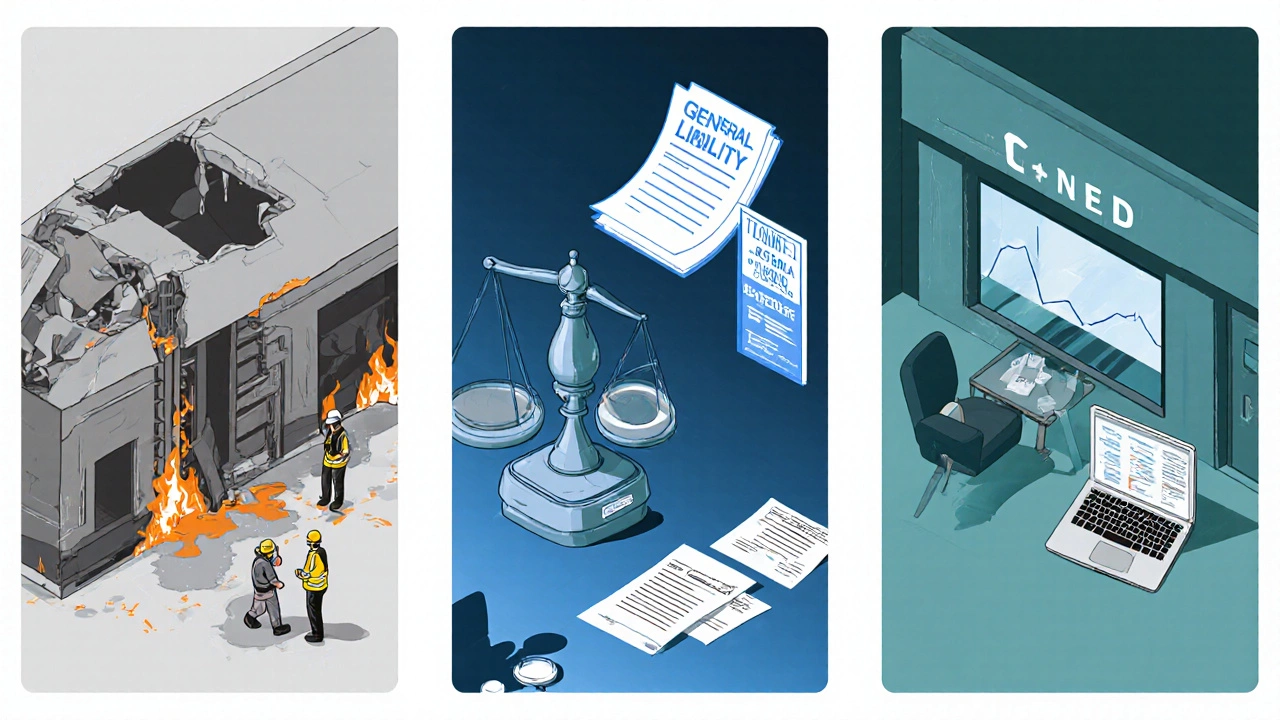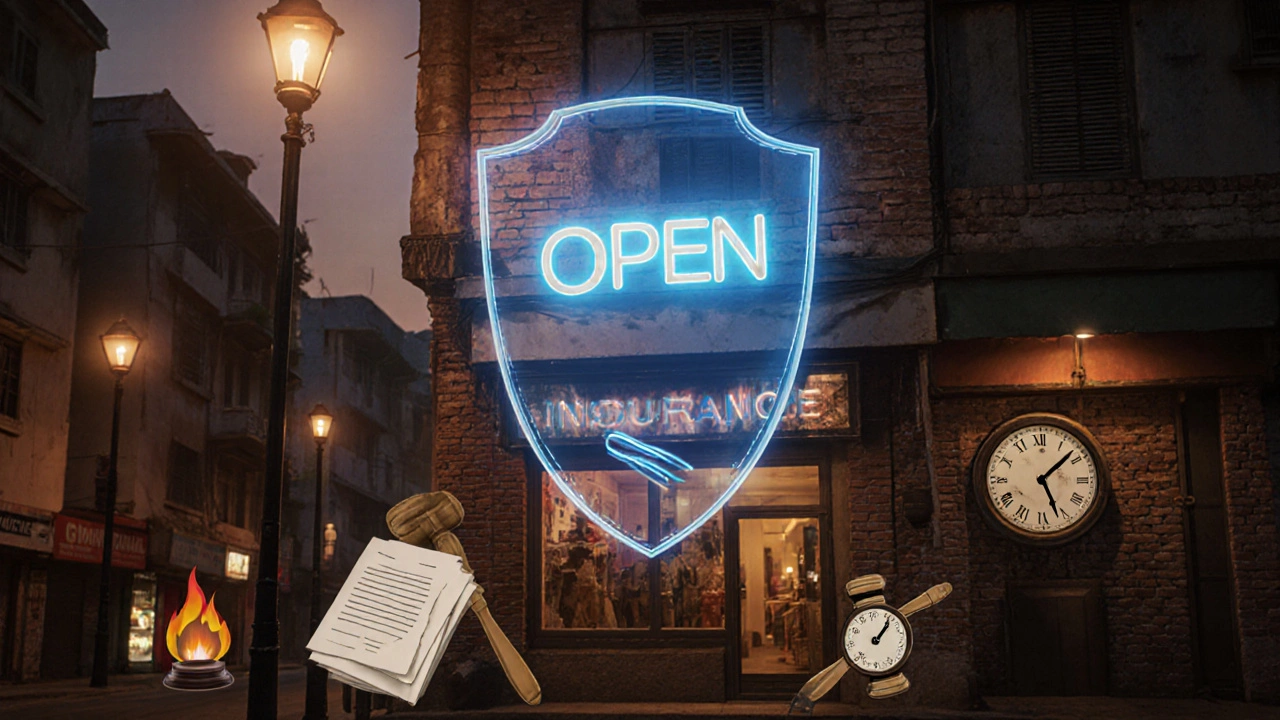Commercial Insurance Coverage Calculator
Your Recommended Coverage Limits
Property Damage:
General Liability:
Business Interruption:
Total Estimated Annual Premium:
Note: These estimates are based on industry averages and may vary depending on your specific business type, location, and risk factors. Consult with a licensed insurance agent for accurate coverage recommendations.
Property Damage
Protects buildings, equipment, inventory, and contents from covered perils like fire, storm, and vandalism.
Typical Range: $500K - $5M
General Liability
Covers third-party claims for bodily injury, property damage, and advertising mistakes.
Typical Range: $1M - $2M
Business Interruption
Reimburses lost income and ongoing expenses during temporary shutdowns due to covered events.
Typical Range: 70% - 100% of Prior Year Revenue
Key Takeaways
- Commercial Insurance bundles property, liability, and business‑interruption protection under one policy.
- Core coverages include Property Damage, General Liability, and Business Interruption coverage.
- Optional extensions like Cyber Liability and Equipment Breakdown fill gaps that standard policies miss.
- Understanding limits, deductibles, and policy exclusions prevents costly surprises.
- Regularly review your risk profile and adjust the commercial coverage mix as your business evolves.
What Is Commercial Insurance?
When you hear the phrase Commercial Insurance is a type of insurance that protects businesses against financial loss caused by property damage, legal claims, and interruptions to operations. In plain terms, it’s the safety net that lets a company keep the lights on after a fire, settle a lawsuit after a slip‑and‑fall, or stay afloat when a supply chain disruption stops sales for weeks.
Core Coverages Every Business Should Have
Most commercial policies bundle three essential coverages. Each addresses a different risk, and together they form the backbone of a solid risk‑management plan.
1. Property Damage
Property Damage protects the physical assets you own or lease - buildings, machinery, inventory, and even the contents of a storefront. The coverage pays for repair or replacement after events such as fire, storm, vandalism, or accidental explosion. For a mid‑size manufacturing firm in 2024, the average property limit hovered around $2million, with a typical deductible of $5,000.
2. General Liability
General Liability shields you from third‑party claims for bodily injury, property damage, or advertising mistakes. If a customer slips on a wet floor in your restaurant and sues for $150,000, general liability steps in. Standard limits for small‑to‑medium businesses range from $1million per occurrence to $2million aggregate.
3. Business Interruption
Business Interruption (also called Business Income) replaces lost revenue when a covered peril forces you to shut down temporarily. The policy reimburses ongoing expenses - rent, payroll, utilities - until you can reopen. A 2023 analysis showed that firms with interruption coverage recovered 78% faster after a hurricane compared to those without.

Optional Extensions That Fill the Gaps
While the core trio covers most baseline risks, many businesses add specialized extensions to match their unique operations.
Equipment Breakdown
Equipment Breakdown replaces or repairs critical machinery that fails from mechanical breakdown, electrical surge, or operator error. For a bakery with $500,000 in ovens, a single oven failure can halt production and cost thousands in lost sales - an expense this rider directly addresses.
Cyber Liability
In 2024, cyber attacks rose 12% year‑over‑year. Cyber Liability covers data‑breach response costs, legal fees, and liability when customer information is compromised. Limits typically start at $250,000 for small firms, with higher tiers for e‑commerce platforms handling large volumes of personal data.
Professional (Errors & Omissions) Liability
Businesses that provide advice, designs, or consulting services face claims of negligence. Professional Liability (also called Errors & Omissions) protects architects, lawyers, and IT consultants from lawsuits alleging faulty advice. Limits can range from $500,000 to $5million, depending on contract requirements.
How Limits, Deductibles, and Exclusions Shape Your Policy
Understanding the levers in a policy prevents unpleasant surprises when a claim arises.
- Coverage Limits: The maximum amount the insurer will pay for a covered loss. Choose limits that reflect the replacement cost of your assets, not just their book value.
- Deductibles: The out‑of‑pocket amount you must pay before the insurer kicks in. Higher deductibles lower premiums but increase cash‑flow risk after an incident.
- Exclusions: Specific situations the policy does NOT cover. Common exclusions include intentional damage, wear‑and‑tear, and certain natural disasters unless you add a separate endorsement.
For example, a retail store might carry a $1million property limit with a $2,500 deductible. If a fire causes $300,000 in damage, the insurer pays $297,500 after the deductible is applied.
Step‑by‑Step Guide to Choosing the Right Commercial Coverage
- Inventory Your Assets - List buildings, equipment, inventory, and intangible assets like brand value.
- Identify Your Biggest Risks - Evaluate exposure to fire, theft, lawsuits, cyber attacks, and supply‑chain disruptions.
- Match Risks to Coverages - Pair each identified risk with the appropriate core or optional coverage.
- Set Limits Based on Replacement Cost - Use professional appraisals or vendor quotes to avoid under‑insuring.
- Choose Deductibles That Fit Cash Flow - Test scenarios: can you absorb a $5,000 deductible without jeopardizing operations?
- Review Policy Language - Highlight exclusions and any required endorsements (e.g., flood insurance for coastal properties).
- Consult a Licensed Agent - An experienced broker can spot gaps and negotiate better terms.
Following this checklist ensures you build a comprehensive shield rather than a patchwork of unrelated policies.
Common Pitfalls and How to Avoid Them
Even savvy owners slip up. Here are the most frequent mistakes and quick fixes.
- Under‑Estimating Property Value: Relying on accounting depreciation instead of replacement cost leaves you exposed. Get a professional re‑valuation every three years.
- Skipping Business Interruption: Many think profit loss isn’t insurable. In reality, a month‑long shutdown can erase a year’s earnings.
- Ignoring Cyber Risks: Small firms often assume hackers target only large corporations. A single ransomware hit can cripple a boutique shop.
- Choosing Too‑Low Limits: Courts may award judgments far beyond typical limits. If you operate in a high‑risk industry, consider umbrella policies.
- Not Updating the Policy: New equipment, staff, or services change exposure. Review your policy annually.
Comparison Table of Core and Optional Coverages
| Coverage Type | Typical Limit | Common Deductible | Primary Use Case |
|---|---|---|---|
| Property Damage | $500,000 - $5million | $1,000 - $10,000 | Repair or replace buildings, equipment, inventory |
| General Liability | $1million per occurrence / $2million aggregate | $500 - $2,500 | Third‑party bodily injury, property damage claims |
| Business Interruption | Based on prior year revenue (often 70% - 100%) | Varies - often integrated with property deductible | Lost income after fire, storm, or other covered event |
| Equipment Breakdown | $250,000 - $1million | $1,000 - $5,000 | Repair or replace malfunctioning machinery |
| Cyber Liability | $250,000 - $3million | None (often no deductible) or $5,000 | Data breach response, legal defense, notification costs |
| Professional Liability | $500,000 - $5million | $2,500 - $10,000 | Claims of negligence or errors in professional services |
Next Steps for Your Business
Now that you know what the typical package looks like, take action:
- Gather recent invoices, asset appraisals, and loss‑history reports.
- Schedule a risk‑assessment session with a licensed commercial insurer.
- Request quotes for the core coverages and at least two optional extensions that match your risk profile.
- Compare the quote details side‑by‑side using the table above.
- Finalize limits and deductibles that align with your cash‑flow forecasts.
- Sign the policy and set calendar reminders for annual reviews.
Doing this before the next fiscal year ensures you’re protected when the unexpected strikes.
Frequently Asked Questions
What is the difference between commercial property and general liability coverage?
Property coverage pays for damage to your own assets - buildings, equipment, inventory - while general liability covers claims made by third parties for bodily injury, property damage they suffer, or advertising mistakes you make.
Do I need business interruption insurance if I work from home?
If you rely on a physical location to produce or store goods, interruption coverage is still valuable. Home‑based consultants often skip it because their income isn’t tied to a premises, but a roof collapse that destroys equipment would still be a loss.
How often should I review my commercial insurance limits?
At least once a year and anytime you make a major purchase, add a new service line, or experience significant growth. A rule of thumb: if your assets have increased by more than 10% since the last review, request an updated quote.
Can I bundle cyber liability with my standard commercial policy?
Many insurers offer cyber as an endorsement to the primary commercial package, which simplifies billing and ensures consistent limits. However, specialized cyber carriers sometimes provide broader coverage for ransomware and data‑privacy regulations.
What are typical exclusions I should watch for?
Common exclusions include intentional acts, wear‑and‑tear, flood (unless added), earthquake (unless endorsed), and losses from nuclear incidents. Always read the exclusion list and ask the carrier for optional riders if any gap worries you.

